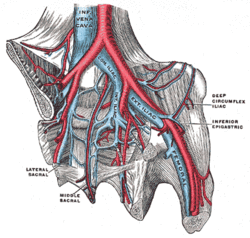A number of veins remove deoxygenated blood from the abdomen and pelvis. The external iliac vein, the upward continuation of the femoral vein, passes upward along the pelvis and ends to form the common iliac vein.The tributaries of the external iliac vein are the inferior epigastric, deep iliac circumflex, and pubic veins.
The internal iliac vein begins near the upper part of the greater sciatic foramen, the large opening at the rear of the pelvis, passes upward behind and slightly medial to the internal iliac artery and, at the brim of the pelvis, joins with the external iliac vein to form the common iliac vein.
The left and right common iliac veins come together in the abdomen at the level of the fifth lumbar vertebra, forming the abdominal vena cava. They drain blood from the pelvis and lower limbs.

Veins of abdomen and lower limbs
The veins of the abdomen and lower limb include the inferior vena cava, the common iliac veins, the external iliac veins, and their tributaries.
The superior epigastric vein refers to a blood vessel that carries deoxygenated blood and drains into the internal thoracic vein. It anastomoses with the inferior epigastric vein at the level of the umbilicus and drains the anterior part of the abdominal wall and some of the diaphragm.
The inferior epigastric vein refers to the vein that drains into the external iliac vein and arises from the superior epigastric vein.
The deep circumflex iliac vein is formed by the union of the venae comitantes of the deep iliac circumflex artery, and joins the external iliac vein about 2 cm above the inguinal ligament.